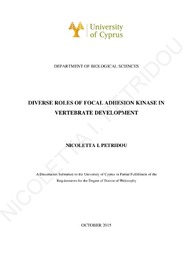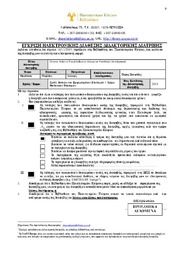| dc.contributor.advisor | Skourides, Paris | en |
| dc.contributor.author | Petridou, Nicoletta I. | en |
| dc.coverage.spatial | Cyprus | en |
| dc.creator | Petridou, Nicoletta I. | en |
| dc.date.accessioned | 2016-03-10T09:14:39Z | |
| dc.date.accessioned | 2017-08-03T09:25:05Z | |
| dc.date.available | 2016-03-10T09:14:39Z | |
| dc.date.available | 2017-08-03T09:25:05Z | |
| dc.date.issued | 2015-11 | |
| dc.date.submitted | 2015-11-16 | |
| dc.identifier.uri | https://gnosis.library.ucy.ac.cy/handle/7/39110 | en |
| dc.description | Includes bibliographical references (p. 224-260). | en |
| dc.description | Number of sources in the bibliography: 428 | en |
| dc.description | Thesis (Ph. D.) -- University of Cyprus, Faculty of Pure and Applied Sciences, Department of Biological Sciences, 2015. | en |
| dc.description | The University of Cyprus Library holds the printed form of the thesis. | en |
| dc.description.abstract | Η κινάση των εστιακών προσκολλήσεων (Focal Adhesion Kinase, FAK) είναι μία μη-υποδοχέας κινάση τυροσίνης σημαντική για σηματοδότηση προερχόμενη από αλληλεπιδράσεις ιντεγκρινών-εξωκυττάριου υποστρώματος και εμπλέκεται σε διαδικασίες κυτταρικής προσκόλλησης και μετανάστευσης. Η FAK είναι απαραίτητη στην εμβρυική ανάπτυξη, καθώς ποντίκια με διαγραφή του γονιδίου της FAK παρουσιάζουν εμβρυικό θάνατο λόγω ελαττωματικής μορφογένεσης του μεσοδέρματος. Παρόλα αυτά, οι συγκεκριμένοι ρόλοι της πρωτεΐνης FAK στην εμβρυογένεση παραμένουν ως επί το πλείστον άγνωστοι. Σε αυτή τη μελέτη, διερευνήσαμε τη λειτουργία της FAK κατά την εμβρυική ανάπτυξη των σπονδυλωτών χρησιμοποιώντας ως πειραματικό μοντέλο το βάτραχο Xenopus laevis. Δημιουργώντας ένα ισχυρό πρωτεϊνικό αναστολέα της FAK καταφέραμε να χαρακτηρίσουμε το ρόλο της στο πρώιμο έμβρυο. Αναστολή της FAK στο ραχιαίο μεσόδερμα οδήγησε σε φαινότυπο παρόμοιο με αυτόν των ποντικών που δεν εκφράζουν FAK και επιπλέον, αποκάλυψε ότι η λειτουργία της FAK στα κεντροσωμάτια κατά τη μίτωση είναι σημαντική στην επιβίωση του μεσοδέρματος. Αναστολή της FAK στο νευροεκτόδερμα οδήγησε στην ανακάλυψη ενός νέου ρόλου κατά τη γαστριδίωση. Συγκεκριμένα, δείχνουμε ότι η FAK είναι απαραίτητη κατά την επιβολή, τη μορφογενετική κίνηση που επιτρέπει στο εκτόδερμα να περικλείσει το έμβρυο. Δείχνουμε ότι η σηματοδότηση προερχόμενη από φιμπρονεκτίνη κατά την επιβολή μεταδίδεται μέσω της FAK με ως αποτέλεσμα να ρυθμίζεται η πολικότητα και παρεμβολή των εκτοδερμικών κυττάρων. Επιπλέον, αποτυχία της επιβολής οδηγεί στο σταμάτημα της γαστριδίωσης, ένας φαινότυπος που διασώζεται με μηχανική ή φαρμακολογική ελευθέρωση της τάσης στον ιστό, αποδεικνύοντας ότι η επιβολή παίζει ένα επιτρεπτικό ρόλο στη γαστριδίωση και επεκτείνοντας την μηχανοβιολογική κατανόηση της γαστριδίωσης.
Περαιτέρω πειραματικές διεργασίες ανακάλυψαν ένα συντηρημένο ρόλο της FAK στη ρύθμιση του προσανατολισμού της μιτωτικής ατράκτου σε διάφορους ιστούς, συμπεριλαμβανομένων θηλαστικών κυττάρων σε καλλιέργεια και επιθηλιακά όργανα στο έμβρυο. Ένας από τους μηχανισμούς με τους οποίους η μιτωτική άτρακτος προσανατολίζεται είναι μέσω αναγνώρισης εξωτερικών δυνάμεων. Όμως, είναι ελάχιστα κατανοητό το πώς αυτές οι δυνάμεις αναγνωρίζονται και μεταφράζονται ενδοκυτταρικά σε βιοχημικά σήματα. Σε αυτή τη μελέτη παρέχουμε τα πρώτα στοιχεία της μοριακής σύνδεσης μεταξύ των εξωκυτταρικών μηχανικών ερεθισμάτων και του προσανατολισμού της ατράκτου. Δείχνουμε ότι η αναγνώριση των δυνάμεων επιτυγχάνεται μέσω ενεργοποίησης της ιντεγκρίνης β1 ανεξάρτητης της πρόσδεσης με συνδέτη, στον πλευρικό φλοιό των μιτωτικών κυττάρων. Αυτό οδηγεί στην προσέλκυση πρωτεϊνών των εστιακών προσκολλήσεων συμπεριλαμβανομένων της FAK, p130Cas και Src στον πλευρικό φλοιό για να σχηματίσουν ένα φλοιώδες μηχανοαισθητήριο σύμπλοκο (Cortical Mechanosensory Complex, CMC) το οποίο είναι υπεύθυνο για τη μεταγωγή του σήματος στην άτρακτο. Επιπλέον, δείχνουμε ότι τα μέλη του CMC και οι μεταξύ τους αλληλεπιδράσεις είναι απαραίτητες για τον προσανατολισμό της ατράκτου, παρέχοντας λεπτομέρειες ως προς το μηχανισμό λειτουργίας του CMC. Προτείνουμε ότι η πολωμένη ενεργοποίηση της ιντεγκρίνης β1 οδηγεί στην ασύμμετρη προσέλκυση των πρωτεϊνών του CMC στο μιτωτικό φλοιό. Αυτό έχει ως αποτέλεσμα τη φωσφορυλίωση της p130Cas μέσω ενός FAK/Src συμπλόκου το οποίο μέσω ενός απροσδιόριστου ακόμα μηχανισμού ευθυγραμμίζει την άτρακτο με το διάνυσμα της μεγαλύτερης εξωτερικής δύναμης. Αυτά τα ευρήματα δείχνουν ότι οι πρωτεΐνες των εστιακών προσκολλήσεων μπορούν να μεταδώσουν μηχανικά ερεθίσματα στο κύτταρο στην απουσία εξωκυτταρικών συνδετών και εισηγούνται ότι έχουν προσαρμοστεί για λειτουργίες εξαρτώμενες και ανεξάρτητες της κυτταρικής προσκόλλησης. | el |
| dc.description.abstract | The Focal Adhesion Kinase (FAK) is a non-receptor tyrosine kinase crucial for integrin-extracellular matrix (ECM) signal transduction and involved in a wide variety of biological processes including cell adhesion and migration. FAK is necessary for embryonic development since targeted disruption of the FAK gene in mice results in embryonic lethality due to general mesodermal deficiency. However, its specific roles in embryogenesis remain largely unknown. In this study, we explored FAK function during vertebrate embryonic development using Xenopus laevis as a model system. By generating a powerful dominant negative of FAK we managed to address FAK function in the early embryo. FAK inhibition in the dorsal mesoderm elicited defects similar to those reported in FAK null mice but in addition, revealed that FAK’s centrosomal function during mitosis is essential for mesodermal survival. FAK inhibition in the prospective neuroectoderm however, uncovered a previously unidentified role of FAK during Xenopus gastrulation. Specifically, we show that FAK is necessary during epiboly, the morphogenetic movement that allows the ectoderm to encompass the entire embryo. We show that a fibronectin-derived signal transduced by FAK governs cell polarity and cell intercalation of ectodermal cells during epiboly. Moreover, failure of epiboly results in gastrulation arrest that can be rescued by both mechanical and pharmacological release of tension within the tissue, demonstrating that epiboly is permissive for gastrulation and furthering our mechanobiological understanding of gastrulation.
Additional work revealed a conserved role of FAK in the control of spindle orientation in several tissues including mammalian cells in culture and epithelial organs in the vertebrate embryo. One of the mechanisms by which the spindle is oriented is through sensing of external forces. However, how are these forces sensed and translated into biochemical signals intracellularly to orient the spindle is poorly understood. In this study we provide the first evidence of the molecular link between external mechanical stimuli and spindle orientation. We show that force sensing is achieved through ligand independent integrin β1 activation at the lateral cortex of mitotic cells. We go on to show that this activation elicits the recruitment of several focal adhesion proteins including FAK, p130Cas and Src to the lateral cortex to form a Cortical Mechanosensory Complex (CMC) which is responsible for the transduction of the signal to the spindle. Further analysis revealed that all three members of the CMC and interactions between them are essential for spindle orientation, providing mechanistic details with respect to the manner in which the CMC operates. Specifically, we propose that polarized activation of integrin β1 leads to the asymmetric recruitment of CMC proteins at the mitotic cortex. This results in the phosphorylation of p130Cas through a FAK/Src complex which, through a yet undefined mechanism, aligns the spindle with the major external force vector. These findings show that focal adhesion proteins can transduce external mechanical stimuli to the cell in the absence of extracellular ligands and suggest that evolutionary they were adapted for both adhesion dependent and independent functions. | en |
| dc.format.extent | xv, 270, [41] p. : col. ill. ; 31 cm. + 1 CD-R | en |
| dc.language.iso | eng | en |
| dc.publisher | Πανεπιστήμιο Κύπρου, Σχολή Θετικών και Εφαρμοσμένων Επιστημών / University of Cyprus, Faculty of Pure and Applied Sciences | |
| dc.rights | info:eu-repo/semantics/openAccess | en |
| dc.rights | Open Access | en |
| dc.subject.lcsh | Cell adhesion | en |
| dc.subject.lcsh | Cell adhesion molecules | en |
| dc.subject.lcsh | Embryology | en |
| dc.subject.lcsh | Vertebrates | en |
| dc.subject.lcsh | Protein kinases | en |
| dc.subject.lcsh | Mesoderm | en |
| dc.title | Diverse roles of Focal Adhesion Kinase in vertebrate development | en |
| dc.title.alternative | Ποικίλοι ρόλοι της κινάσης των εστιακών προσκολλήσεων στην ανάπτυξη των σπονδυλωτών | el |
| dc.type | info:eu-repo/semantics/doctoralThesis | en |
| dc.contributor.committeemember | Σκουρίδης, Πάρης | el |
| dc.contributor.committeemember | Σανταμά, Νιόβη | el |
| dc.contributor.committeemember | Γεωργιάδης, Παντελής | el |
| dc.contributor.committeemember | Ζάχος, Γεώργιος | el |
| dc.contributor.committeemember | Skourides, Paris | en |
| dc.contributor.committeemember | Santama, Niovi | en |
| dc.contributor.committeemember | Georgiades, Pantelis | en |
| dc.contributor.committeemember | Zachos, George | en |
| dc.contributor.committeemember | Parsons, Maddy | en |
| dc.contributor.department | Τμήμα Βιολογικών Επιστημών / Department of Biological Sciences | |
| dc.subject.uncontrolledterm | ΚΙΝΑΣΗ ΕΣΤΙΑΚΩΝ ΠΡΟΣΚΟΛΛΗΣΕΩΝ | el |
| dc.subject.uncontrolledterm | ΕΜΒΡΥΙΚΗ ΑΝΑΠΤΥΞΗ | el |
| dc.subject.uncontrolledterm | ΣΠΟΝΔΥΛΩΤΑ | el |
| dc.subject.uncontrolledterm | ΕΣΤΙΑΚΕΣ ΠΡΟΣΚΟΛΛΗΣΕΙΣ | el |
| dc.subject.uncontrolledterm | ΠΡΟΣΑΝΑΤΟΛΙΣΜΟΣ ΜΙΤΟΤΙΚΗΣ ΑΤΡΑΚΤΟΥ | el |
| dc.subject.uncontrolledterm | ΙΝΤΕΓΚΡΙΝΗ Β1 | el |
| dc.subject.uncontrolledterm | ΕΠΙΒΟΛΗ | el |
| dc.subject.uncontrolledterm | ΜΕΣΟΔΕΡΜΑ | el |
| dc.subject.uncontrolledterm | FAK | en |
| dc.subject.uncontrolledterm | EMBRYONIC DEVELOPMENT | en |
| dc.subject.uncontrolledterm | VERTEBRATES | en |
| dc.subject.uncontrolledterm | FOCAL ADHESIONS | en |
| dc.subject.uncontrolledterm | SPINDLE ORIENTATION | en |
| dc.subject.uncontrolledterm | INTEGRIN Β1 | en |
| dc.subject.uncontrolledterm | EPIBOLY | en |
| dc.subject.uncontrolledterm | MESODERM | en |
| dc.identifier.lc | QP552.C42P48 2015 | en |
| dc.author.faculty | Σχολή Θετικών και Εφαρμοσμένων Επιστημών / Faculty of Pure and Applied Sciences | |
| dc.author.department | Τμήμα Βιολογικών Επιστημών / Department of Biological Sciences | |
| dc.type.uhtype | Doctoral Thesis | en |
| dc.rights.embargodate | 2016-05-16 | |
| dc.contributor.orcid | Skourides, Paris [0000-0003-3502-5729] | |
| dc.gnosis.orcid | 0000-0003-3502-5729 | |


